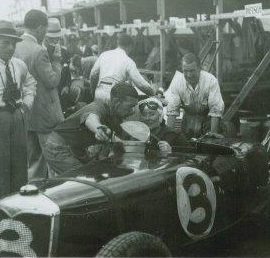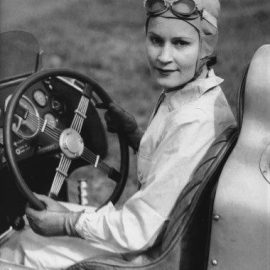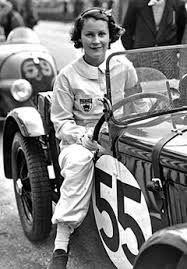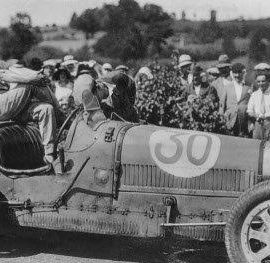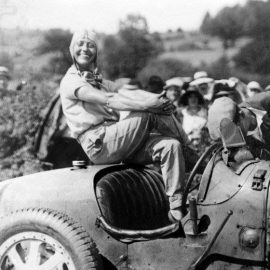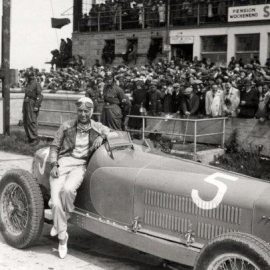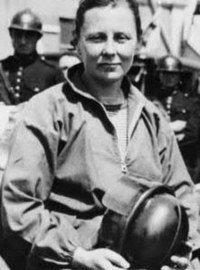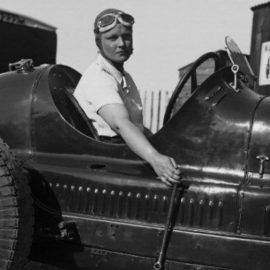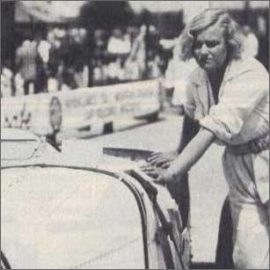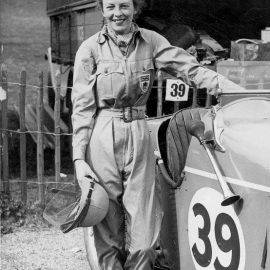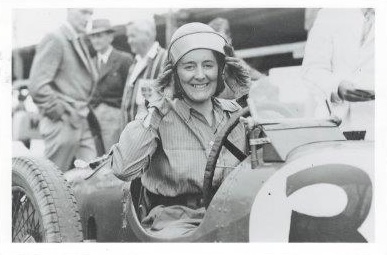
02 May The Lady Racers
The pre-war South African GPs attracted the world’s finest female competitors. Wendy Monk recalls their achievements…
Eileen Ellison was the first lady to participate in an SAGP, her entry being accepted “as a way to encourage lady spectators” according to the event’s instigator Brud Bishop. In 1936 she entered a supercharged Bugatti T37A in the 2nd SAGP. Eileen became interested in racing during the 1920s, and won the Duchess of York’s race for women drivers at Brooklands in 1932. She took part in hill climbs, speed trials and GPs in Europe driving such cars as Bugatti, Lagonda and Maserati with mixed success. For the SAGP she entered a racing two-seater Bugatti T37A but the Bugatti’s supercharged 1496 cc engine overheated and seized due to the special racing fuel having jellied in the heat, causing a blockage. But while they lasted, Eileen and her car were a great success with the crowd. Eileen eventually settled in South Africa where her late husband had owned properties.
In 1937 it was the turn of Kay Petre to compete with the men. Petre was a tiny lady who started her racing career in 1933 in a Wolseley Hornet Special, but later on drove an Invicta, a Bugatti, Austin (she was part of the work’s team) and Rileys. She raced at Brooklands, Donington Park and Crystal Palace, was a successful hill-climber, took part in rallies and at Le Mans. In 1937, Petre entered a Freddie Dixon-prepared Riley TT Sprite in the 3rd SAGP and astonished everyone with her driving skills, making her way around the circuit at average speeds of 86 mph (138 km/h). Although not a front runner, she completed 17 of the 18 laps and was credited with 11th place out of 28 starters. This was followed by taking sixth place at the Grosvenor GP, and she was lying seventh on Lap 31 of the Rand GP when the Riley’s back axle broke. Returning to the Grosvenor circuit for the Farewell Handicap, in a continuing run of bad luck Petre was lying first when the Riley’s back axle broke again, forcing her out on Lap 17 of the 23-lap race. Back in England, driving for the works Austin 7 team at Brooklands, Petre was seriously injured in a crash and, as a result, never raced again.
Fay Taylour should be the most revered lady in motor racing history but her political beliefs got in the way of an illustrious career. In 1939 she finally made it to South Africa for the 5th and final SAGP after entering too late for the 1936 race. Taylour was a world famous 1920s champion speedway and dirt track racer competing on equal terms with men until women were banned from the sport in 1930, so she turned to racing cars and was successful at venues including Brooklands, Shelsley Walsh and the Mille Miglia. Cars she drove included a Chevrolet, Talbot Le Mans 105, Adler Trumpf and Alfa Romeo 8C Monza. The SAGP was run to the newly-created voiturette formula and Taylour entered a Dixon-prepared unblown Riley. She managed to run around midfield in the early stages but fell out at Orange Grove with engine failure. The last lady competitor to take part in pre-war SAGP series, Taylour did two more races in SA before returning to the UK.
Apart from this courageous trio, three other ladies almost made it to the 1936 SAGP but their entries were received too late and, sadly, rejected, denying the crowd of further exceptional female talent. Doreen Evans started her motor sport career when she was 17 years old. She drove a variety of MGs at events including the RAC Rally, Shelsley Walsh hill climbs, Brooklands 500-mile and was part of the works 1935 Le Mans team. Gwenda Stewart started her career racing motorcycles before she moved on to cars, taking part in a few GPs and two Le Mans 24-Hour events. She became Brooklands Speed Queen with a speed of 135,95 mph (225 km/h), a record that still stands. Former model and dancer Helle Nice became a GP driver for Bugatti in the early-1930s, successfully driving a T35C in several events. Later on she also drove an Alfa Romeo Monza, and competed in international GPs, hill climbs and rallies including the Monte Carlo Rally.




